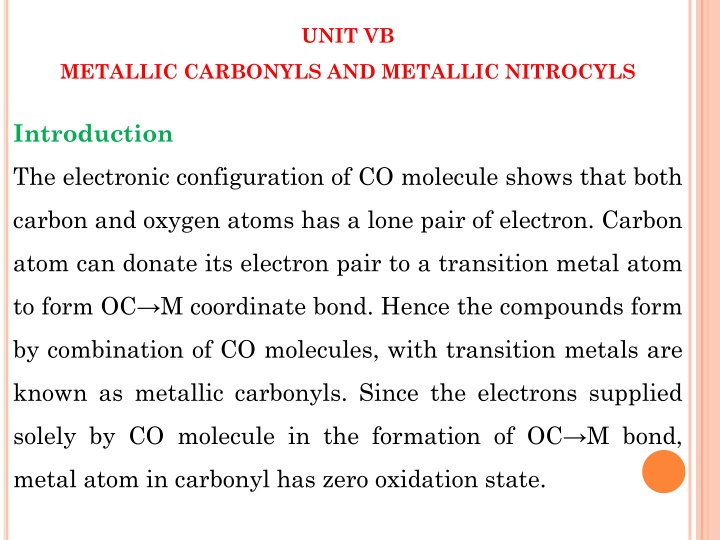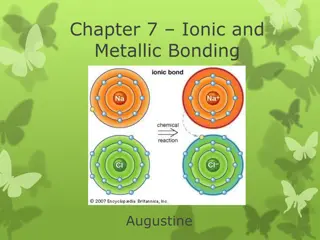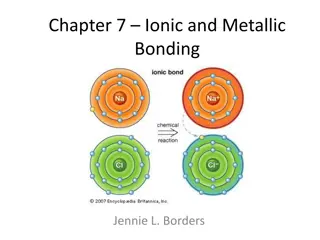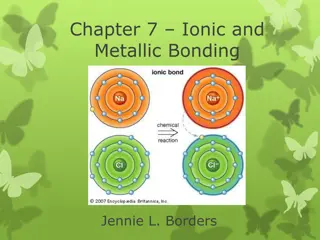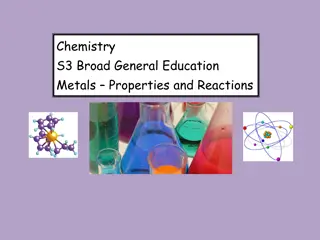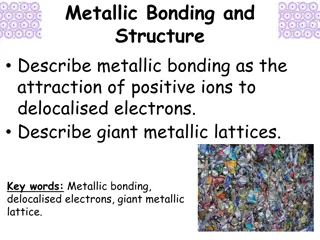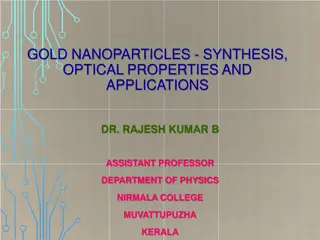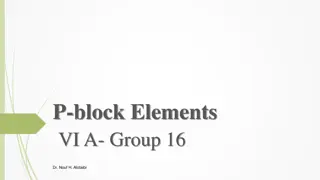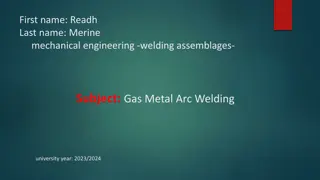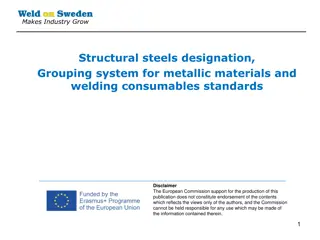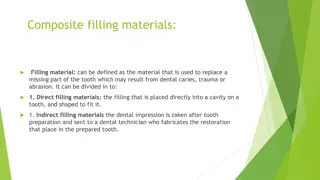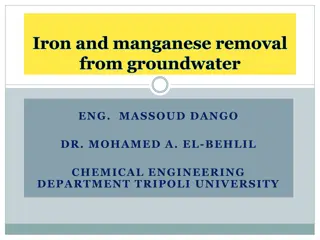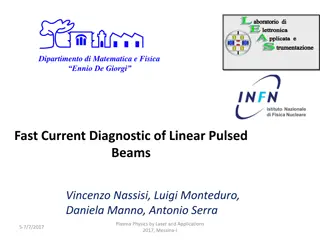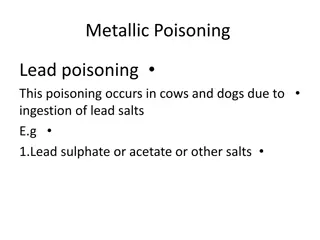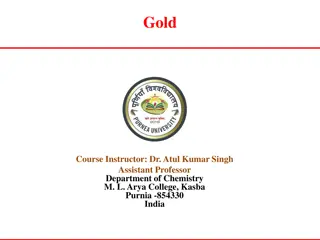Overview of Metallic Carbonyls and Metallic Nitrocyls
Metallic carbonyls and metallic nitrocyls are compounds formed by the combination of CO molecules with transition metals. These compounds have unique bonding characteristics due to the lone pair of electrons present in the CO molecule. Metallic carbonyls are classified based on the number of metal atoms per molecule and can be prepared by direct synthesis or by carbonylating metallic salts with CO in the presence of reducing agents. Various methods of preparation and specific examples of metallic carbonyls are discussed in detail.
Download Presentation

Please find below an Image/Link to download the presentation.
The content on the website is provided AS IS for your information and personal use only. It may not be sold, licensed, or shared on other websites without obtaining consent from the author.If you encounter any issues during the download, it is possible that the publisher has removed the file from their server.
You are allowed to download the files provided on this website for personal or commercial use, subject to the condition that they are used lawfully. All files are the property of their respective owners.
The content on the website is provided AS IS for your information and personal use only. It may not be sold, licensed, or shared on other websites without obtaining consent from the author.
E N D
Presentation Transcript
UNIT VB METALLIC CARBONYLS AND METALLIC NITROCYLS Introduction The electronic configuration of CO molecule shows that both carbon and oxygen atoms has a lone pair of electron. Carbon atom can donate its electron pair to a transition metal atom to form OC M coordinate bond. Hence the compounds form by combination of CO molecules, with transition metals are known as metallic carbonyls. Since the electrons supplied solely by CO molecule in the formation of OC M bond, metal atom in carbonyl has zero oxidation state.
Carbonyls have been classified on the basis of the number of metal atoms present in the carbonyl i. Mononuclear (or monomeric) carbonyl: Which is having only one metal atom per molecule and having type M(CO)y. e.g. V(CO)6, Cr(CO)6 etc. Polynuclear carbonyl: Which contain two or more metal atoms per molecule having type ii. Mx(CO)y. how ever some authors call carbonyls containing two metal atoms are called bridged carbonyl and which containing more than two metal atoms are called polynuclear carbonyls which may be homonuclear e.g. Fe3(CO)12 or hetereonucear [e.g. MnCo(CO)9, MnRe(CO)10].
GENERAL METHODS OF PREPARATION (i) Direct Synthesis (ii)By carbonylating metallic salts with CO in presence of educing agent (iii)Preparation of Mo(CO)6 and W(CO)6 from Fe(CO)5 (iv)Preparation of Fe2(CO)9, and Os2(CO)9 from Fe(CO)5
Direct Synthesis Only Ni(CO)4 and Fe(CO)5 and Co2(CO)8 are normally obtained by the action of CO on the finely divided metal at suitable tempreture and pressure. o 200 C, 100 atm press. 5CO + Fe(CO) Fe 5 R.T., 100 atm press. 4CO + Ni Ni(CO) 4 o 200 C, 100 atm press. 8CO + 2Co Co 2CO) 8
By carbonylating metallic salts with CO in presence of reducing agent Metallic carbonyls are obtained when salts like RuI3,CrCl3, VCl3, CoS, Co(CO)3, CoI2 etc. are treated with CO in presence of suitable reducing agent like Mg, Ag, Cu, Na, H2, AlLiH4 etc. o 115 C, 70 atm press. 5CO + + Cr(CO) + + CrCl LiAlH LiCl AlCl 3 4 6 3 o 175 250 C, atm press. 10CO + + 2Ru(CO) + RuI 6Ag 6AgI 3 5 o 25 C, 210 atm press. + Mn (CO) 2MgI + + 2 MnI 10CO diethyl (in 2Mg 2 2 5 2 ether) 200 C, o 200 atm press. 8CO + + + 2 CoS 4Cu Co (CO) 2Cu S 2 8 2 200 C, o 200 atm press. 10CO + + 2Fe(CO) + 2 FeS 2Cu Cu S 5 2 200 C, o 200 atm press. 8CO + + + 2Co I 4Cu Co (CO) 4CuI 2 2 8
200 C, o 200 atm press. 5CO + + Fe(CO) + 2Fe I 2Cu Cu I 2 5 2 2 250 C, o 120 -200 300 - atm press. 8CO + + + + 2 CoCO 2H Co (CO) 2CO 2 H O 3 2 2 8 2 2 o 160 C, 300 atm press. + + C3Mg(acac) + 2 Cr(acac) 12 CO Mg 3 2Cr(CO) 3 2 6 (inpyridin 6CO 5 + e) 5Na + diglyme) (in Mo(CO) + MoCl 5NaCl 6 Sometimes CO acts as a carbonylating and reducing agent as under. o 25 0 C, 350 atm press. + Os(CO) + OsO CO 5 2O 5 5 2 + + Re O 10 CO Re (CO) 7O 2 7 2 10 2 V(CO)6 is prepared by the method represented by the following equation o 100 C, 150 atm press. + + V(CO) + VCl CO 6 Na 3NaCl 3 (indiglyme 6 acidificat ion by H PO ) 3 4
Preparation of Mo(CO)6 and W(CO)6 from Fe(CO)5 MoCl5 and WCl5 give the corresponding hexacarbonyls. These reactions are characterized by low yield, which can be improved by using high pressure. o 110 ether C, + + + MoCl Fe(CO) 3 Mo(CO) 3FeCl 9CO 6 5 6 2 o 110 ether C, + + + WCl Fe(CO) 3 W(CO) 3FeCl 9CO 6 5 6 2
Preparation of Fe2(CO)9, and Os2(CO)9 from Fe(CO)5 When cool solution of Fe(CO)5 and Os(CO)5 in glacial CH3COOH is irradiated with ultra-violet light, Fe2(CO)9, and Os2(CO)9 are obtained respectively. light UV - + e(CO) F Fe CO) CO 5 2 9 light UV - + Os(CO) Os CO) CO 5 2 9
GENERAL PROPERTIES Physical properties Most carbonyls are volatile solids but Fe(CO)5, Ru(CO)5, Os(CO)5 and Ni(CO)4 are liquids at ordinary temperature and quite inflammable. Many of these decompose or melt at low temperature. They are soluble in organic solvents. Ni(CO)4 is insoluble in water but others react with it. All carbonyls, except V(CO)6, are diamagnetic substances. Metals with odd atomic number couple the odd electrons to form metal-metal bond. Probably the steric factor prevents V(CO)6 from dimerization. All carbonyls are thermodynamically unstable with respect to oxidation in air, but their rates vary widely. Co2(CO)8 reacts at ordinary temp. Fe2(CO)9 and Ni(CO)4 are also readily oxidized (their vapours forming explosive mixtures with air); M(CO)6, M = Cr, Mo, W react only when heated.
Chemical properties Substitution reaction CO groups can be replaced by monodentate ligands like isocynide (CNR), PR3, PCl3, py, CH3OH etc. e.g. Ni(CO)4 + 4CNR Ni(CNR) + 4CO Ni(CO)4 + 4PCl3 Ni(PCl3) + 4CO Fe(CO)5 + 2CNR Fe(CO)3(CNR)2 +2CO Mn2(CO)10 + PR3 2Mn(CO)4(PR3) + 2CO 2Fe2(CO)12 +3py Fe3(CO)9(py)3 + 3Fe(CO)5 2Fe2(CO)12 +3CH3OH Fe3(CO)9(CH3OH)3 + 3Fe(CO)5
Bidentate ligands like diars, o-phen, NO2 etc. replace at two or more CO group at a time. e.g. Mo(CO)6 + diars Mo(CO)4(diars) + 2CO Fe(CO)s + diars Fe(CO)3diars +2CO Ni(CO)4 + o-phen Ni(CO)2(o-phen)2 + 2 CO Ni(CO)4 + diars Ni(CO)2(diars) + 2 CO Cr (CO)6 + 2diars Cr(CO)2(diars)2 + 4CO Ni(CO)4 + 2NO2 Ni(NO2)2 + 4CO
(ii) Action of NaOH or Na metal Aqueous or alcoholic solution of NaOH reacts with Fe(CO)5 to form carbonylate anion, [HFe(CO)4]- [H Na 3NaOH + 0) (Fe = + + - 2 + -] Fe(CO) Fe (CO) Na CO + 3 H O 5 4 2 2 H-atom in [H+Fe2-(CO)4]- ion is acidic which means that Fe-atom in this ion is in -2 oxidation state. Na-metal in liquid NH3 converts Fe2(CO)9, Co2(CO)8, Fe3(CO)12, Cr(CO)6, Mn2(CO)10 etc in to carbonylate anions and in these carbonyls are reduced. Na 2 4Na + 0) (Fe = Na 2 2Na + 0) (Co = + - 2 - 2 Fe (CO) [Fe (CO) ] + CO 2 9 2 4 + - - Co (CO) [Co (CO) ] 2 8 4 + - - Fe (CO) = + 3Na 3 Na [Fe (CO) ] 3 12 4 (Fe 0) + - 2 - 2 Cr(CO) + 6 2Na Na [Cr (CO) ] + CO 2 5 = (Cr 0) + - - Mn (CO) = + 2Na 2 Na [Mn (CO) ] 2 10 5 (Mn 0)
(iii) Carbonyl react with halogens to form carbonyl halides Fe(CO)5 + X2 Fe(CO)4X2 + CO Mo(CO)6 + Cl2 Mo(CO)4Cl2 + 2CO Mn2(CO)10 + X2 (X=Br, I) 2Mn(CO)5X Co2(CO)8 and Ni(CO)4 both get decomposed into metallic halides and CO when treated with halogens. e.g. Co2(CO)8 + 2X2 2CoX2 + 8CO Ni(CO)4 + Br2 NiBr2 + 4CO
(iv) Action of NO Many carbonyl react with nitric oxide to form metal carbonyl nitrosyls. e.g Fe(CO)5 + 2 NO Fe(CO)2(NO)2 + 3CO 3Fe2(CO)9 +4NO 2Fe(CO)2(NO)2 +Fe2(CO)5 + Fe3(CO)12 + 6CO Fe3(CO)12 + 6NO 3Fe(CO)2(NO)2 + 6CO Co2(CO)8 + 2NO 3Co(CO)3(NO) + 2CO Moist NO gives a blue coloured compound, Ni(NO)(OH) with Ni(CO)4while dry NO gives a blue solution of the composition, Ni(NO)(NO2) 2Ni(CO)4 + 2NO + 2H2O 2Ni(NO)(OH) + 8CO + H2 Ni(CO)4 + 4NO Ni(NO)(NO2) + 4CO + N2O
(v) Action of H2 When Mn2(CO)10 and Co2(CO)8 react with H2, they are reduced to carbonyl hydride, Mn(CO)5H and Co(CO)4H respectively. 200 atm. press. + + - 0 Mn (CO) H 2[Mn (CO) H ] 2 10 2 5 o 165 C, 200 atm. press. + + - 0 Co (CO) H 2[Co (CO) H ] 2 8 2 4
(vi) Action of Heat Different carbonyls give different product when heated shown bellow. o 250 C + Fe(CO) Fe 5CO 5 o 70 cool C, + 3Fe (CO) 3Fe(CO) Fe (CO) 2 9 5 3 12 (in toluen e) o 140 cool C, + Fe (CO) 3Fe 12CO 3 12 o 50 atmosphere inert C, + 2Co (CO) Co (CO) 4CO 2 8 4 12 o 180 C + Ni(CO) Ni 4CO 4 o 50 C + 3Fe (CO) 2Fe (CO) CO 3 2 9 3 12 (in toluen e)
Structure and nature of M-CO bonding in carbonyls The lone paired of electron on carbon atom would expected to form strong -dative bond due to electron density remain to the carbon nucleus. Formation of dative -bonds It is form as a result of overlapping of empty hybrid orbital of metal atom with the filled hybrid orbital on carbon atom of CO molecule and form M CO -bonds. i.e. formation of Ni CO -bonds in Ni(CO)4 takes place by the overlap between empty sp3 hybrid orbital on Ni and filled sp orbital on carbon atom of CO molecule. Other three Ni CO bonds are formed in the same manner. In the type of M(CO)5 and M(CO)6 carbonyls dsp3 and d2sp3 hybrid orbital are used for M CO -bonds. In this bond formation, metal atom acts as electron acceptor, while CO acts as electron donor.
Formation of dative -bonds This bond is formed as a result of overlapping of filled d orbitals or hybrid dp orbitals of metal atom with low-lying empty p -orbitals on CO molecule. i.e. M CO i.e. Ni CO -bond in Ni(CO)4 form by overlap between filled dz2 or dx2-y2 on Ni atom and empty * molecular orbital on CO molecule. M CO -bond form by overlapping with filled dxy, dyz or dxz orbital of M with empty * molecular orbital on CO molecule. Out of six CO, three are linked by M CO -bond and remaining three is linked by M CO and M CO -bond. As M-CO donation increases, the M-C bond becomes stronger and the C=O bond becomes weaker. Thus the multiple bonding would result in shorter M-C bonds and longer C-O bonds as compared M-C single bonds and C=O triple bonds respectively. The C-O bond lengths are rather insensitive to bond order, the M-C bonds show appreciable shortening consistent with bonding concept.
Effective atomic number rule (EAN) In the formation of M CO bond, CO molecule electron pair to the metal atom. Thus the metal atom is said to be have zero valency. The rule is state that After CO groups donated a certain number of electron pairs to the zero valent metal atom through OC M -bonding, the total number of electron on metal atom including those gained from CO molecule becomes equal to the atomic number of the next inert gas . EAN = z + 2Y = G Where, z = total electrons of metal atom Y = total electron donated by CO groups In carbonyls, CO can donate two electrons at a time, so only even number of transition metal can achieve the effective atomic number of next inert gas. e.g. for Cr(CO)6, EAN = z + 2Y = 24 + (2x6) = 36 = Ar G = Effective atomic number of next inert gas
1) Mononuclear carbonyl having transition metal atom in even atomic number Metal No. of s on the No. of s EAN of the metal atom in carbonyl central metal donated by CO carbonyl atom = At. No.of molecule = 2Y = z + 2Y metal = z Cr(CO)6 24 6 x 2 = 12 24 + 12 = 36[Kr] Mo(CO)6 42 6 x 2 = 12 42 + 12 = 54 [Xe] W(CO)6 74 6 x 2 = 12 74 + 12 = 86 [Rn] Fe(CO)5 26 5 x 2 = 10 26 + 10 = 36 [Kr] Ru(CO)5 44 5 x 2 = 10 44 + 10 = 54 [Xe] Os(CO)5 76 5 x 2 = 10 76 + 10 = 86 [Rn] Ni(CO)4 28 4 x 2 = 8 28 + 8 = 36 [Kr]
2) Mononuclear carbonyl having transition metal atom in odd atomic number V(CO)6 and hypothetical carbonyls Mn(CO)6 and Co(CO)4 carbonyls do not obey EAN rule because metal atom do not achieve next inert gas configuration. V(CO)6: 23 + (2 x 6) = 35 Mn(CO)5: 25 + (2 x 5) = 35 Co(CO)4: 27 + (2 x 4) = 35 3) Polynuclear carbonyl: Two s each of M-M bond present in these carbonyls are included in calculating the s per metal atom. Mn2(CO)10: s from two Mn = 25 x 2 = 50 s from ten CO = 2 x 10 = 20 s from one Mn-Mn bond = 2 hence EAN of each Mn atom = 72/2 = 36 [Kr] Fe3(CO)12: s from three Fe = 26 x 3 = 72 s from twelve CO = 2 x 12 = 24 s from three Fe-Fe bonds = 6 hence EAN of each Fe atom = 108/3 = 36 [Kr]
18-electron rule as applied to metallic carbonyls The formation of mononuclear carbonyls by transition elements with even atomic number can also be explained on the basis of 18-electron rule as shown below. i.e. Ni(CO)4: No. of the valence electrons of metal atom = 10 No. of the electrons donated by CO groups = 8 Total number of electrons on the metal atom = 18 Fe (CO)5: No. o f the valence electrons of metal atom = 8 No. of the electrons donated by CO groups = 10 Total number of electrons on the metal atom = 18 Cr(CO)6: No. of the valence electrons of metal atom = 6 No. of the electrons donated by CO groups = 12 Total number of electrons on the metal atom = 18
The formation binuclear carbonyls having metal atom with odd atomic number can also be explained on the basis of 18-electron rule as shown below for Co2(CO)8 and Mn2(CO)10 carbonyls. Co2(CO)8: No. of the valence electrons of two Co atoms = 2 x 9 = 18 No. of the electrons donated by CO groups = 2 x 8 = 16 No. of electron for Co-Co bond = 1 x 2 = 2 Total number of electrons on two Co atoms = 36 Therefore electrons on one Co atom = 36/2 = 18 Mn2(CO)10: No. of the valence electrons of two Mn atoms = 2 x 7 = 14 No. of the electrons donated by CO groups = 2 x 10 = 20 No. of electron for Mn-Mn bond = 1 x 2 = 2 Total number of electrons on two Mn atoms = 36 Therefore electron s on one Mn atom = 36/2 = 18
Though Fe has an even atomic number (i.e. 26), the formation of its binuclear carbonyl, Fe2(CO)9 can also accounted for by the 18-electron rule as under. Fe2(CO)9: No. of the valence electrons of two Fe atoms = 2 x 8 = 16 No. of the electrons donated by CO groups = 2 x 9 = 18 No. of electron for Fe-Fe bond = 1 x 2 = 2 Total number of electrons on two Fe atoms = 36 Therefore electrons on one Fe atom = 36/2 = 18
SOME INDIVIDUAL CARBONYLS Nickel tetra carbonyl, Ni(CO)4: 2. Iron pentacarbonyl, Fe(CO)5: 3. Chromium hexacarbonyl, Cr(CO)6: 4. Dimanganese decacarbonyl, Mn2(CO)10: 5. Dicobalt octacarbonyl, Co2(CO)8: 6. Di-iron nonacarbonyl, Fe2(CO)9: 7. Tri-iron dodecacarbonyl, Fe3(CO)12:
Nickel tetra carbonyl, Ni(CO)4 Preparation: 1) Direct synthesis: CO is passed over reduced Ni at 60 oC C o 60 Ni(CO) CO 4 Ni + 4 2) From NiI2: NiI2 is heated with Co in the presence of a halogen receptor. I Ni(CO) CO 4 NiI + + 2 4 2 + 4+ NiS CO 4 Ni(CO) S 3) From nickel salt: Passing CO through alkaline suspension of NiS or Ni(CN)2 + + Ni(CN) CO 4 Ni(CO) C N 2 4 2 2
Properties: 1) Colorless liquid having m.p. -25o C and b.p. 43 oC, insoluble in water but dissolves in organic solvents. It decomposes at 180 200 oC. 2) Action of H2SO4 : Ni(CO)4 + H2SO4 NiSO4 + H2 + 4CO 3) Action of NO: 2Ni(CO)4 + 2NO + 2H2O 2Ni(NO)(OH)+ 8OH + H2 4) Substitution reactions: replaced by monodentate ligands like isocynide (CNR), PR3, PCl3, py, CH3OH etc. Ni(CO)4 + 4CNR Ni(CNR) + 4CO 5) Action of heat: 4CO Ni Ni(CO) 4 o 180 C + 6) Action of Halogen: 7) Action of gaseous HCl Gaseous Hcl decomposes the solution of Ni(CO)4, evolving H2 and CO Ni(CO)4 + 2HCl(g) NiCl2 +H2 + 4CO Ni(CO)4 + Br2 NiBr2 + 4CO
Uses: Since Ni(CO)4, on heating, is decomposed to metallic nickel, it is use in the production of nickel by Mond s process. It is also used in gas planting and as a catalyst.
METAL NITROSYL The coordination compounds of transition metals containing NO+ ion as ligand are metal (or metallic) nitrosyls. Examples of metal nitrosyls are: Metal nitrosyl carbonls: [Co-(NO+)(CO)3]0, [Fe2-(NO+)2(CO)2]0, [Mn3-(NO+)3(CO)]0, [Mn-(NO+)(CO)4]0, [V-(NO+)(CO)5]0 etc. Metal nitrosyl halides: [Fe-(NO+)2I]2, [Fe2-(NO+)2(CO)2]0, [Fe-(NO+)2I]0, [Fe2-(NO+)3Cl]0, [Co- (NO+)2X]0 (X=Cl, Br, I), [M-(NO+)2Cl2]0 (M=Mo or W). Metal nitrosyl thio complexes: These compounds are given by only Fe, Co and Ni. M+[Fe-(NO+)2S]-, M+[Co-(NO+)2S]-, M+[Ni-(NO+)2S]- (M=Na+, K+, NH4). Metal nitrosyl cyano complexes: [Mn+(NO+)(CN)5]2-, [Fe+(NO+)(CN)5]2-, [Mn+(NO+)(CN)5]3-, [Mo+(NO+)(CN)5]4-. Micellaneous metal nitrosyl complexes: [Co+(NO+)(NH3)5]2+, [Co+(NO+)(NO2)5]3-, [Fe+(NO+)]2+, [Ru2+(NO+)(NH3)4Cl]2+, [Ru2+(NO+)Cl5]2-, [Fe2-(NO+)2(PR3)3]0.
Preparation: (i) Metal nitrosyl carbonyls can be obtained by the action of NO on metal carbonyls, e.g., Fe(CO) 2NO Fe(CO) 5 + (NO) 2Fe(CO) 4NO 3Fe(CO) 2 9 + C 85 6NO (CO) Fe 12 3 + C 40 2NO (CO) Co 8 2 + 95 C o + (NO) 3CO 2 2 + + + Fe(CO) Fe (CO) 6CO 2 5 3 12 o + 3Fe(CO) (NO) 6CO 2 2 o + 2Co(CO) (NO) 2CO 3 (ii) Metal nitrosyls halides can be prepared: By the action of NO on metal halides in the presence of a suitable metal (e.g. Co, Zn etc.) which acts as a halogen acceptor, e.g. CoX2+ 4NO + Co 2[Co(NO)2X] 2NiI2 + 2NO + Zn 2[Ni(NO)I] + ZnI2 By the action of halogen on nitrosyl carbonyls, e.g., 2[Fe(CO)2(NO)2] + I2 [Fe(NO)2I]2 + 4CO
Properties of metal nitrosyl carbonyls: Substitution reactions: NO+ ions are more firmly attached with the metal ion than the CO groups hence, treated with ligands like PR3, CNR, phen etc., it is only CO groups that are replaced by these ligands, e.g., Fe(CO)2(NO)2+2L(L=PRa, CNR) Fe(L)2(NO)2+2CO Fe(CO)2(NO)2+phen Fe(phen)(NO)2+2CO Action of halogens: Many metal carbonyl nitrosyls, when treated with halogens, are converted into metal nitrosyl halides, eg., 2[Fe(CO)2(NO)2]+I2 [Fe(NO)2I]2+4CO Properties of metal nitrosyl halides: Metal nitrosyl halides react with other ligands to form mono-nuclear complexes, e.g., [Fe(NO)2X]2 + 2L 2[Fe(NO)2XL] Iron nitrosyl halide, [Fe(NO)2I]2 reacts with K2S and CH3CI to form dark red compounds which have the composition, K2[Fe(NO)2S]2 and [Fe(NO)2(SCH3)]2 and are called Roussin's salts. In these compounds Fe is in -1 oxidation state.
Sodium nitroprusside, Na2[Fe2+(CN)5(NO+)]: Preparation: (i) By the action of NaNO3 on Na4[Fe2+(CN)6] Na4[Fe2+(CN)6] + NaNO2 + H2O Na2[Fe2+(CN)5(NO+)] + 2NaOH + NaCN (ii) by passing nitric oxide (NO) into acidified solution of Na4[Fe(CN)6]. 2Na4[Fe(CN)6] + H2SO4 + 3NO 2Na2[Fe(NO)(CN)5] + 2NaCN + Na2SO4 + l/2 N2 + H2O
Properties: Sodium nitroprusside forms beautiful ruby red rhombic crystals which are soluble in water. When freshly prepared sodium nitroprusside is added to a solution containing sulphide ion (i.e. Na2S but not H2S), a purple or violet colour is produced. the production of this colour is due to the formation of Na4[Fe2+(CN)5(NO+)(S2-)]. The production of this purple or violet colour is used to confirm the presence of S2- ion in a given mixture. Na2S + Na2[Fe2+(CN)5(NO+)] Na4[Fe2+(CN)5(NO+)(S2-)] Alkali sulphites give a rose red colour due to the formation of Na4[Fe(CN)5(NO)(SO3)]. This reaction can be used to dis- tinguish sulphites from thiosulphates which do not show this reaction. Na2SO3 + Na2[Fe(CN)5(NO)] Na4[Fe(CN)5(NO)(SO3)] (Violet or purple colour)
With silver nitrate a flesh coloured Ag2[Fe(CN)5(NO)] is produced. 2AgNO3+Na2[Fe(CN)5(NO)] Ag2[Fe(CN)5(NO)]+2NaNO3 Aldehydes and ketones containing CH3-CO-R group give deep red colour with sodium nitroprusside and excess of NaOH. It is converted into sodium ferrocyanide, Na4[Fe(CN)6] on treatment with an alkali. 6Na2[Fe(CN)5(NO)] + 14NaOH 5Na4[Fe(CN)6] + Fe(OH)2 + 6NaNO3 + 6H2O According to another view NO+ groups present in nitroprusside is oxidized to NO2 and thus a nitro complex is obtained. Na2[Fe(CN)5(NO)] + 2NaOH Na4[Fe(CN)5(NO2)] + H2O [Fe(CN)5(NO)]2- ion has diamagnetic character. Its diamagnetic character confirms the fact that NO is present as NO+ ion in this complex ion.
Structure: [Fe(CN)5(NO)]2- was formerly supposed to contain Fe(+3) ion but Pauling in 1931 and Sidgwick in 1934 suggested that the odd electron of NO group enters the valence-shell of Fe (+3) ion making Fe in +2 oxidation state. Thus NO radical acquires one positive charge and gets coordinated to Fe(+2) ion as NO+ radical. This view is supported by the fact that Na2[Fe(CN)5(NO)] is diamagnetic where as K3[Fe(CN)6] is paramagnetic. Thus in [Fe(CN)5(NO)]2- there are total three positive charges (Fe = +2, NO = +1] and five negative charges due to the presence of five CN groups. Hence total charges acquired by [Fe(CN)5(NO)] is -2. In other words the formula of sodium nitroprusside is Na2[Fe2+(CN)5 (NO+)]. [Fe2+(CN)5(NO+)]2- has octahedral structure with Fe2+ ion located at the centre of the octahedron. Uses: It is use as a reagent in qualitative analysis for the detection of sulphides, sulphites, aldehides and ketones containing CH3-CO-R group.
Nitroso ferrous sulphate, FeSO4NO or [Fe+(NO+)]SO4: When, to the aqueous solution of a metallic nitrate (say NaNO3) is added freshly prepared solution of FeSO4 and a few drops of conc. H2SO4 along the sides of the test tube, a brown ring of nitroso ferrous sulphate, [Fe+(NO+)]SO4 is obtained at the junction of the two liquids in the test tube. The formation of nitroso ferrous sulphate takes place through the following equations: 6NaNO3 +H2SO4 NaHSO3 + HNO3 [or NO3- + H+ HNO3] 6FeS04 + 2HNO3 + 3H2SO4 3Fe2(SO4)3 + 2NO + 4H2O [or 3Fe2+ + NO3+ + 4H+ 3Fe3+ + NO + 2H2O] (C) FeSO4 + NO FeSO4NO or [Fe+(NO+)]2+SO42- [or Fe2++ NO [Fe+(NO+)]2+ ]
In aqueous solution [Fe+(NO+)]2+ ion is better expressed as [Fe(NO)(H2O)5]2+. It is a paramagnetic substance corresponding to the presence of three unpaired electrons, since solution magnetic measurements give 3.90 B.M. as the value of its magnetic moment. This value supports the fact that Fe is in +1 oxidation state in this complex ion i.e. it is a high spin complex of Fe (+1) (3d7 system) with NO+. The complex has N O stretching frequency at 1745 cm-1 which indicates the presence of strong -bonding and the intense brown colour strongly suggests Fe+ NO+ charge transfer. Uses: The formation of [Fe+(NO+)]2+ ion has been utilized in the detection of NO3- ion in a given inorganic salt.
Effective atomic number (EAN) rule as ap| metallic nitrosyls: Metallic nitrosyls also obey the EAN shown below for certain nitrosyls. In these cases NO (assumed to be a unipositive ion, NO+ and hence acts as a electron donor. Metal atoms are, therefore, in negative o state. (i) [Co-(CO)3(NO+)]0: s from Co- = 27 + 1 = 28 s from 3 CO = 2 x 3 = 6 s from NO+ = 1 x 2 = 2 hence EAN of each Co atom = 36 [Kr] (ii) [Fe2-(CO)2(NO+)2]0: s from Fe2- = 26 + 2 = 28 s from 2 CO = 2 x 2 = 4 s from NO+ = 2 x 2 = 4 hence EAN of each Fe atom = 36 [Kr]
(iii) [Fe2-(NO+)2(Pr3)2]0: s from Fe2- = 26 + 2 = 28 s from NO+ = 2 x 2 = 4 s from 2 Pr3 = 2 x 2 = 4 hence EAN of each Fe atom = 36 [Kr] (iv) [Mn3-(CO)(NO+)3]0: s from Mn3- = 25 + 3 = 28 s from CO = 1 x 2 = 2 s from 3 NO+ = 3 x 2 = 6 hence EAN of each Fe atom = 36 [Kr]
